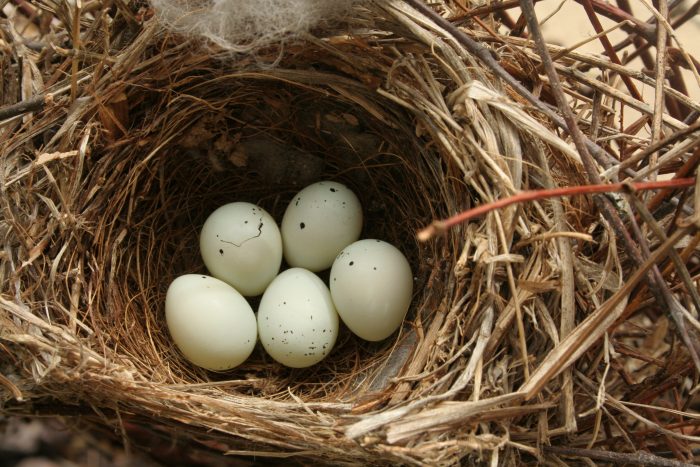If you’ve seen house finches flying around with cigarette butts in their beaks, rest assured that these birds are not smoking. They are using the cigarette butts to line their nests.
At the end of June, the Journal of Avian Biology published a paper by Monserrat Suárez-Rodriguez and Constantino Macías Garcia, who presented the results of an experiment they designed to find out what was going on with the cigarette butts. Initial evidence suggested that nicotine and other chemicals in the butts might function as an insect repellent—after all, nicotine is used in some pesticides—but the evidence wasn’t conclusive.

So Rodriguez and Garcia set up an experiment with 32 finch (Carpodacus mexicanus) nests and waited until the eggs hatched. After hatching, the researchers removed the nest lining that the birds had created and replaced it with felt, to eliminate any parasites that might have settled into the nest while the birds were brooding.
They then divided the nests into three groups and added live ticks to 10 of the nests, dead ticks to another 10, and left 12 free of ticks. The researchers found that the adult birds were much more likely to add cigarette butt fibers to the nest if it contained ticks. The birds even changed their behavior based on whether the ticks were dead or alive, adding 40% more butt material to nests with live ticks than those with dead ticks. Rodriguez and Garcia believe that the results of the experiment suggest that the finches really are using the cigarette butts as insect repellent to keep the ticks out of their nests.
Sadly, the butts have a negative impact, too. The scientists discovered that the chemicals in the butts cause genetic damage by interfering with the birds’ cell division. No one knows if the benefits of the butts outweigh the costs, because it takes years before the extent of genetic damage is fully known.
The finches aren’t the only species that use found materials as medicine. Many animals use plans and other materials as medicine. Wood ants and honey bees incorporate antimicrobial resin into their nests, and monarch butterflies lay their eggs on milkweed, which repels parasites. Several species of birds eat clay to aid in digestion and kill bacteria. Mammals self-medicate, too. For example, spider monkeys eat certain plants to increase or decrease their fertility, baboons eat a plant known to kill flatworms, and pregnant elephants eat the leaves that induce delivery.
So how do animals learn which materials to use for which purpose? The simplest explanation is that one day an animal has a stomach ache—or another condition—and eats a plant, and feels better. The next time she has a stomach ache she remembers the plant and eats it again and once again feels better. Or, one day a finch builds a nest and lines it with Marlborough butts (their preferred brand), and notices, “hey—no ticks,” and then remembers this next time she builds a nest and collects butts to use as lining.
Some animals pass on their acquired knowledge to their progeny. Others inherit the behavior through natural selection. Cigarette butts, however, haven’t been around all that long (roughly 100 years), and that is a relatively short time for natural selection. So, are the finches somehow sharing this information with one another? Might they have a kind of culture, like apes and cetaceans?